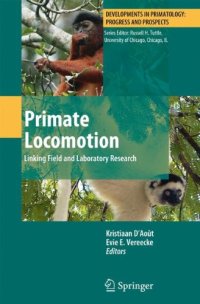
Ebook: Primate Locomotion: Linking Field and Laboratory Research
- Tags: Evolutionary Biology, Animal Anatomy / Morphology / Histology, Animal Physiology, Developmental Biology, Anthropology
- Series: Developments in Primatology: Progress and Prospects
- Year: 2011
- Publisher: Springer-Verlag New York
- Edition: 1
- Language: English
- pdf
Primate locomotion has typically been studied from two points of view. Laboratory-based researchers have focused on aspects like biomechanics and energetics, whereas field-based researchers have focused on (locomotor) behaviour and ecology. Primate Locomotion: Linking Field and Laboratory Research brings together both aspects of primate locomotion studies. Communication between both groups is necessary to identify the specific needs and start up achievable and successful research projects in the field. This volume brings together biomechanists, ecologists, and field-based researchers, who combine both disciplines, and whose contributions facilitate lasting cooperation between the mentioned disciplines and stimulate innovative research in Primatology. The book will be valuable for primatologists, paleo-anthropologists, biomechanists and field biologists, as well as students. About the Editors: Dr. Kristiaan D’Aout is Assistant Professor in the Department of Biology, University of Antwerp, Belgium. Dr. D’Aout is also Research Associate for the Locomorph Project and Coordinator of Biodynamics Research at the Centre for Research and Conservation at the Royal Zoological Society of Antwerp, Belguim. Evie E. Vereecke is part of the Primate Evolution and Morphology Group, School for Biomedical Sciences, University of Liverpool, UK; and Laboratory for Functional Morphology, Department of Biology, University of Antwerp, Belgium.
Primate locomotion has typically been studied from two points of view. Laboratory-based researchers have focused on aspects like biomechanics and energetics, whereas field-based researchers have focused on (locomotor) behaviour and ecology. Unfortunately, to date, there is relatively little scientific exchange between both groups. With a book, which will be the result of a symposium on the 2008 Meeting of the International Primatological Society in Edinburgh, we would like to bring together laboratory and field-based primate locomotion studies. We are convinced this will be beneficial for both research lines. For example, biomechanists might wonder how frequently the locomotor style they study in the lab actually occurs in nature, and field workers might use calculated costs of locomotion to understand why certain locomotor behaviours are favoured under specific conditions. Thus, on the one hand, an established link between both groups may help interpret the results by using each other’s findings. On the other hand, recent technological advances (e.g. portable high-speed cameras) make it possible to bridge the gap between lab-based and field-based research by actually collecting biomechanical data in situ. Again, communication between both groups is necessary to identify the specific needs and start up achievable and successful research projects in the field. In order to generate a wide interest, we have invited biomechanists, ecologists, and field-based researchers who combine both disciplines, and we hope their combined contributions will facilitate lasting cooperation between the mentioned disciplines and stimulate innovative research in Primatology. We are convinced that the most appropriate format to publish the different symposium contributions is a conference volume within an existing book series. Firstly, the chapters will not only contain new data but will also review existing data and elaborate on potential future work – more so than can be done in a journal article. Secondly, the combination of chapters will form an entity that is more valuable than the sum of the separate chapters and therefore they need to be presented together. Lastly, this volume will benefit from the typically long "shelf life" of a book in a renowned series, allowing it to be used as reference book for both researchers and students.